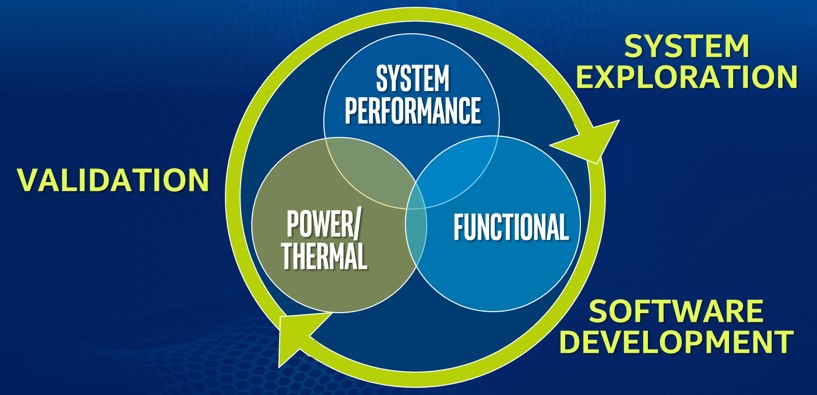Simulation helps architects and developers connect the dots between system exploration, software development and validation. A key advantage of designing systems with Intel® silicon components is the ability to gain faster time-to-market by taking advantage of the tools that Intel offers for optimizing system design, testing power/thermal performance, and simulating hardware platforms to support software development and validation.

System Design Optimization
Customers can solve performance/cost optimization issues and improve workload efficiency in the early design phases by using Intel® CoFluent™ technology to accelerate time-to-market. System architects use it to optimize the platform mix of CPU, memory and I/O configurations and to decide on memory hierarchy, network topology, wireless channels, and workload characterization. Intel CoFluent technology also supports prototyping, return on investment (ROI) analysis, scale-up/scale-out scenarios, investment strategy, performance/pricing analysis, and market positioning to enable rapid design wins.

Intel CoFluent technology delivers value at all levels of integration, from chips to cloud data centers. Chip and systems on a chip (SoC) designers use Intel CoFluent technology to optimize block sizing such as buffer/first-in first-out (FIO) buses, arithmetic logic unit (ALU) elements, and more. They also use it to characterize and optimize algorithms.
Systems architects use Intel CoFluent technology for platform components selections, workload characterization/benchmarking, as well as for new intellectual property (IP) development. Data center managers and DevOps professionals use Intel CoFluent technology to prototype their systems-of-systems to enable workload balancing—particularly for AI workloads—and to optimize system, rack, data center and even multi-cloud configurations.
Power and Thermal Optimization

Intel also offers the capability to predict and optimize power and thermal profiles during system design with Intel® Docea™ technology. In fact, customers report up to a nine months’ head start on power design and validation.
Three solutions comprise Intel Docea technology:
- The Thermal Profiler helps thermal engineers and hardware designers assess dynamic thermal performance with virtual prototyping.
- The Power Simulator helps system engineers and hardware/software architects to virtually prototype and test different power and thermal management strategies.
- Power Analytics helps hardware/software architects and business decision makers collaborate online to manage, predict and report power key performance indicators (KPIs).
Intel Docea technology helps system architects and engineers to develop, test and validate system-level power and thermal performance. Power architects use Intel Docea technology’s collaborative power modeling platform to secure power KPIs for projection and tracking. Power and performance analysts and power management architects use Intel Docea technology to prototype and tune power/thermal management algorithms for pre-silicon power and performance analysis. System architects and software teams use Intel Docea technology to debug and validate their power and thermal management software. Thermal engineers accelerate thermal design by using Intel Docea technology to extend thermal validation coverage by taking into account transient effects.
Virtual Platform Simulation
System architects and software developers can validate critical internal and third-party software and firmware before silicon is ready using Simics® Virtual Platform models. The software is available through Wind River*. Architects and developers use Simics during software development and validation for faster production readiness of their software stacks across a broad range of industries.

Customers report up to six months faster time-to-market, in large part by optimizing time spent debugging software without waiting for hardware availability. Simics software provides a fast, function-accurate, full-system virtual platform to simulate any computer-based system on a standard PC, server, or cloud service. Developers can run their full software stacks, including firmware, boot code, drivers, OS, middleware and applications.
Simics Virtual Platforms extend across hardware generations and give software developers access to fast, stable, easy-to-update systems without waiting for hardware manufacturing volumes to ramp-up. Ecosystem partners and subcontractors can shorten lead times through collaboration and sharing rather than describing and recreating work.
Simics software helps assure quality as it accelerates time-to-market by efficiently automating hardware and software variation and executing rapid yet complete validation testing.
Related Content
- An End-to-End Video Analytics Solution — Intel CoFluent technology with Intel® AI Products can model and simulate an optimal video analytics and AI solution
- Running Large Software on Wind River Simics Virtual Platforms — To run real-world software on the virtual platform, the Simics team strives for target scalability and simulation speed
- Design and Validate Microarchitecture with Intel CoFluent Studio — Intel engineers present a flow used to design and validate the microarchitecture of a packet-processing module for Intel® chipsets
- Using TPCx-BB Express Benchmark* — Using this benchmark to evaluate the performance of software and hardware components for big data clusters
- Intel CoFluent Technology Optimizes Ericsson* Cloud Solutions — Modeling and simulations on Ericsson* Hyperscale Datacenter System 8000 (Ericsson HDS 8000)* for cloud platforms
Author
 Michael Greene is VP & general manager of the Intel System Technologies and Optimization Division. He leads a worldwide organization responsible for increasing development velocity and time to market for Intel platforms. He also serves as the vice chair of GEM Board of Directors. GEM is a national non-profit providing programming and full fellowships to support under-represented individuals who pursue a master’s or doctorate degree in science or engineering. Follow Michael Greene on Twitter*, @greene1of5.
Michael Greene is VP & general manager of the Intel System Technologies and Optimization Division. He leads a worldwide organization responsible for increasing development velocity and time to market for Intel platforms. He also serves as the vice chair of GEM Board of Directors. GEM is a national non-profit providing programming and full fellowships to support under-represented individuals who pursue a master’s or doctorate degree in science or engineering. Follow Michael Greene on Twitter*, @greene1of5.